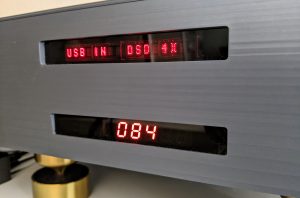That actually offers us three pieces of information: it is a label ("record label"), it deals with re-issues of recordings, and it is known for "audiophile-quality sound recordings". This label differs from most others as it focuses its efforts on re-issues of already recorded and previously released material, unlike other labels that record and release new music. This also means they don't have to promote new artists which eliminates a risk of releasing music that nobody likes. And one more thing—MoFi does not have to rush their releases—they can take as much time as they need to work on material until it is really ready to be released.
It is not the only label of its kind. Another most active ones are: Analogue Productions, Pure Pleasure, First Impression Music, Audio Fidelity, ORG (Original Recordings Group), and there is also a Polish one - GAD Records. Of course also "regular" labels do re-issue their previous releases, but for them it is just a small part of their activity—the ones I named deal only with re-issues focusing their efforts on offering the best possible sound quality. As for sound quality the only labels that may compete with MOFI are Japanese ones.
The Past
Mobile Fidelity Labs released their first records in 1950ties and the man behind that idea was a sound engineer, and a steam engine railroad trains fan, Mr Brad Miller (1939–1998). His passion for steam trains played a great role here because he recorded the sounds of steam trains for the others steam locomotives lovers like himself. His puristic approach to recording process quickly gained him a lot of respect also among audiophiles. His recordings were used during different audio shows starting (by accident) a new tradition of listening to non-musical but perfectly recorded samplers. As you can see even the best of us happen to have bad days.
It was not until Mr Miller moved to Burbank, California in 1971 that MOFI released some records with popular and orchestral music. The history as we know actually started only in 1977, when company moved again its headquarters, this time to Veralade, Washington. This part of company's history began with the Original Master Recording series. The records were made using so called "half-speed" technique developed originally back in 1950ties by Decca, and later improved by JVC for quadraphonic CD-4 recordings.
"Half-speed Mastering" records are pressed from disc lacquers cut at 1/2 normal playing speed and these are first transfers from tape to record. Actually during the process the tape is played at half speed and the disc lacquer is also cut at half speed. It turned out that this simple solution allowed signal to be written on record with much wider frequency range (especially in treble area), while the distortion level was lower and dynamics higher. Despite the fact that quadraphonic recordings did not conquer the market this technique developed for them found it use.
The first ever "half-speed" record released by MOFI carried works of Mystic Moods Orchestra playing popular music. The records were pressed in Japan by JVC on a virgin "Supervinyl", that was a harder and more durable vinyl than traditional formulas. These pressings exhibit a very low surface noise, as well as fewer pops and clicks. This material was used until late 1980ties.
While continuing to release LP titles, Mobile Fidelity entered the CD market in the mid 1980s with its line of Original Master Recording aluminum CDs made by Sanyo in Japan. The aluminum CD line was discontinued in 1987, replaced by the gold-plated "Ultradisc" series. The first CD made in USA was A Night at the Opera (1975) by Queen in 1992. Also the series name was changed to Ultradisc II. After that a time has come for hybrid SACDs.
Today
Since 1998 Mobile Fidelity has been using Studer A-80 1⁄4 inch tape machine, which was custom modified by audio designer Tim de Paravicini, the owner of EAR Yoshino (one can meet the man during HighEnd Show in Munich), who once also consulted for such brands as: Luxman, Quad and Musical Fidelity. Let me rimind you that Jacek Gawłowski who copied and remastered all Czesław Niemien's albums also used A80 fr that process.
The key element of the whole process was using a master tape as a source material. One of the top priorities of Mobile Fidelity was always using as early generation of master tape as possible. Therefore each project started with a search for a proper master tape. If the searched failed the project was not realized.
Label made an exception in 2000 for its re-issue of John Lennon's full catalog. As it turned out the tape used wasn't the original master tape but a new version of the material approved by Yoko Ono. The original tapes were "hidden" and from this point on the only "master tape" to be used were these new, Yoko Ono approved ones. To avoid any misunderstandings few years later MOFI started a new series called "Silver Label", for records produced from digital masters.
Kind of Blue
I chose Mobile Fidelity Labs to better show you the mechanism of releasing audiophile quality re-issues because of my sentiment towards this label, because I believe that this is the "oldest" label dealing with such releases and also because I have just received a box with the new re-issue of Miles Davis' Kind of Blue (Mobile Fidelity Sound Lab MFSL 2-450011, 2 x 45 RPM, 180g LP [1959/2015]). This new purchase raised, not for the first time, the question of how many re-issues of particular album should be even released?
This hit album was originally released by Columbia Records in 1959 (CS8163) using so called "deep groove" vinyl—which was a heavy kind with deeper than regular groove. The stereo version was mixed using three tracks tape as it was a standard for jazz recordings at the time. Simultaneously also a mono version was recorded. In 1950s. Columbia used four tape recorders in their studios—two three-track ones and two mono ones—to make "safety" copies. Unfortunately the mono version was erased.
According to what Steve Berkowitz told Michael Framer, he together with engineer Mark Wilder, has overseen all of the Miles Davis reissues going back many years, and could confirm that the original 3-track tapes are now in very poor condition even though they sat untouched in the vault from 1959 until 1992. It was then when Wilder discovered the KOB speed anomaly that resulted in side one of the original album being slightly sharp in pitch because the 3 track recorder was running slightly slow during the recording session. All version released after 1992 were corrected to remove this problem. For the mono version a correct tape was used (more HERE).
Kind of Blue is one of the most often re-issued jazz albums. Apart from the 50-anniversary box, with poorly pressed blue vinyl (2008), there are also re-issues by Sony, Classic Records (they did it three times—first on 180g vinyl, next on 200g, and finally on one-side 45 RPM vinyl released in 1997), Jazz Wax Records (2011), and even the special edition on a clear vinyl by DOL from 2013. Also Music on Vinyl released its limited edition (only 3000 copies) as a double album with two extra tracks. As a source they used a 24/96 digital file (2011). Plus one can find on the market numerous editions from many countries like: Holland, Russia and Japan. One of the latest limited (1500 copies) releases came from Newbury Comics on 180 g Marbled Blue Vinyl (2015).
How many times?
Mobile Fidelity also prepared a new version released as double, 45 RPM album on 180g vinyl. Why would we need it since there are already so many previous releases?
There are two main reasons for preparing another re-issue of an album—to make more money using the same music, or to improve the sound quality over previous releases and to make money of it. The first case involves putting on market a new release using old mastering and/or mix, on a medium of similar quality. The second option involves creating a new mastering and/or remixing the old material, and/or using a different medium for the release.
Being objective I need to say that usually it is about money. Most re-issues over the years were only means of earning money. With the renaissance of vinyl records thing got more complicated. Music fan had a chance to purchase inexpensive, well prepared versions of the recordings that had been unavailable on the market for years, except for often heavily worn off copies of old releases. The sound quality wasn't the most important thing about these new releases, although they often offered at least decent one. The key issue was a new opportunity for many music fans to get to know new (for them) titles. The original releases as well as the re-issues from specialized brands were rather pricey and many simply couldn't afford them. So the new re-issues had also an educational role to play.
The Mobile Fidelity releases have quite a different role to play though. These are made to offer as good sound quality as possible. The benchmark here is the original release, the first press (usually)—for many of these recordings master tapes are as old as 50 or more years! To achieve the best possible transfer of the material from the tape mastering systems have being modified to produce highest quality lacquer to then press the highest quality records. This techniques are constantly developed allowing to achieve better results which gives new re-issues real sense.
After all if there had been no demand in Japan for new but better quality re-issues (one has to convince people somehow to buy again albums they already have in their collections—better sound quality should do the trick) of jazz and classic music there would be no new CD formats like XRCD (and K2 and K2HD), HQCD (a new, improved version called Ultimate HiQuality CD was recently presented), Blu-spec CD and Blu-spec CD2, as well as SHM-CD and crème de la crème: Platinum SHM-CD. And believe me, each of them was a significant step towards perfection.
Situation with vinyl records is similar. Specialized companies usually perform remastering themselves. The own high quality mastering systems and their own cutting loathes for lacquers. Each new attempt of transferring material from original master tape to vinyl gives slightly different results—one has to consider that tape and vinyl are to different worlds. So there is always a chance that one of the new transfers will result in even better version of the recording, offering even more profound experience for listeners.
As many as it takes
Because that's what this whole business is actually about—another versions of the same original material are supposed to result in a more natural, simply better musical experience. This will allow fans to find something new in music they well know, something they have never found in it before, and on the other hand music could reach some place inside listener that it has never reached before. Therefore I buy many versions of albums by Depeche Mode, Pet Shop Boys, Davis, Dylan, classical music hoping that the next one will sound better, that it will allow the music I already know so well to "speak" to me in a new way, on a new level. So my answer to the question: how many times..." is: "as many as it takes".
The "Audiophiles and are proud of it" series:
- PRAISE OF FORMAT part 2: High Fidelity Pure Audio, April 1st 2015, No. 132, see HERE
- PRAISE OF FORMAT part 1: Compact Cassette, March 1st 2015, No. 131, see HERE
Text: Wojciech Pacuła
Images: Wojciech Pacuła
The input in Wikipedia regarding Mobile Fidelity Labs starts with a phrase:
Mobile Fidelity Sound Lab (MFSL or MoFi) is a re-issue record label known for the production of audiophile-quality sound recordings.
english Wikipedia.org [as per: Oct 16. 2015]










































